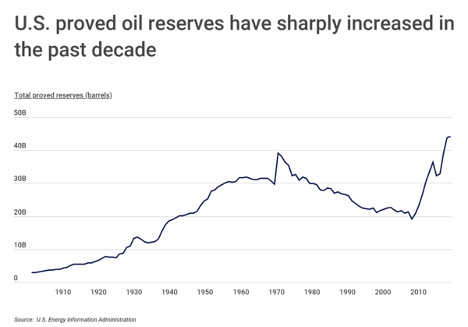 JustTheFacts Max
JustTheFacts Max![]() -
March 7, 2022 -
Business -
Oil reserves
-
3.9K views -
0 Comments -
0 Likes -
0 Reviews
-
March 7, 2022 -
Business -
Oil reserves
-
3.9K views -
0 Comments -
0 Likes -
0 Reviews

Like many sectors of the economy, the energy industry has faced new challenges due to the COVID-19 pandemic. Shifts in demand, production capacity, and distribution networks related to the virus have led to imbalances in supply and demand. As a result, businesses and consumers who rely on petroleum and its byproducts are now confronting shortages in supply—and seeing higher prices as a result.
While the current conditions are unique and likely temporary, concerns about oil shortages are nothing new. Since before the energy crisis of the 1970s, experts have warned of “peak oil”—the point at which oil production from available reserves reaches maximum capacity and begins to diminish. But despite predictions that oil production is poised for decline, advances in geological understanding and technology like horizontal drilling and fracking have expanded production in recent years.
These new techniques were first widely adopted in the early to mid-2000s, and since then, the oil business in the U.S. has transformed. From the early 1980s to around 2008, U.S. oil production fell from 3.1 billion barrels to 1.8 billion per year, while oil imports doubled from 2.1 billion to approximately 5 billion. Since then, imports have fallen sharply while production and exports have grown. As a result, oil production today is over 4 billion barrels annually, and in 2020, the U.S. became a net exporter of oil for the first time.
One important metric for capturing the growth in the oil industry in the U.S. is proved reserves. The U.S. Energy Information Administration defines proved reserves as the estimated volume of recoverable hydrocarbon resources under current economic and operating conditions, which can shift based on new discoveries, shifts in production capacity, or improved techniques and technologies. Proved reserves in the U.S. had peaked historically at 39 billion barrels in the early 1970s before falling by more than half, to 19 billion, in 2008. In the years since, proved reserves have spiked to above 44 billion barrels as new extraction techniques have taken hold.
Some states have seen more significant effects from the recent boom in oil production than others. For example, Texas has seen a 51.7% increase in the size of its proved oil reserves over the last five years. Further cementing its place as the top oil state in the U.S. With more than 18.6 billion barrels of proved oil reserves, Texas now has more than three times the total of the next-highest state, North Dakota (5.9 billion). But some other states have also been rapidly climbing up the list of major oil-producing states, with states like New Mexico (134.1% increase over the last five years) and Oklahoma (64.9%) seeing dramatic growth in the size of their reserves due to improvements in production.
Researchers at Construction Coverage analyzed the U.S. Energy Information Administration data to determine the states with the most crude oil-proved reserves. Then, the five-year change in proved reserves was calculated for each state for reference. Researchers also included the number of operating refineries in each state as a point of contact.
The most recent EIA data shows crude oil proved reserves in California totaled 2.2B barrels in 2019, following a 22.5% decline since 2014. Still, out of all U.S. states with at least one million barrels, California has the 5th most crude oil proved reserves. Here is a summary of the data for California:
Crude oil proved reserves (million barrels): 2,213
5-year change in proved reserves (percent): -22.5%
5-year change in proved reserves (million barrels): -641
Number of operating refineries: 14
For reference, here are the statistics for the entire United States:
Crude oil proved reserves (million barrels): 44,191
5-year change in proved reserves (percent): +21.5%
5-year change in proved reserves (million barrels): +7,806
Number of operating refineries: 124
For more information, a detailed methodology, and complete results, you can find the original report on Construction Coverage’s website: https://constructioncoverage.com/research/states-with-the-most-oil-reserves-2022
Source: Mike LaFirenza

At Desert Local News, connections are everything. We're not just another social networking platform—we're a lively hub where people from all walks of life come together to share stories, spark ideas, and grow together. Here, creativity flourishes, communities grow stronger, and conversations spark global awareness.